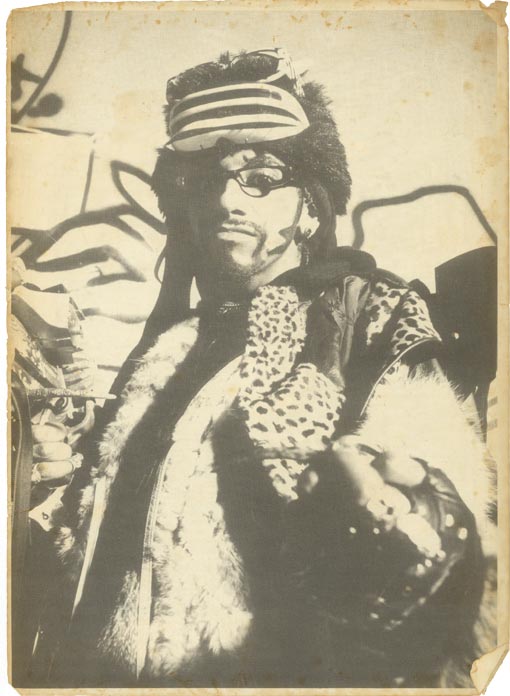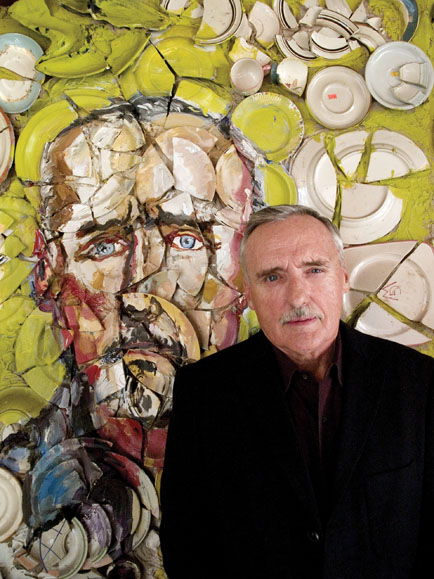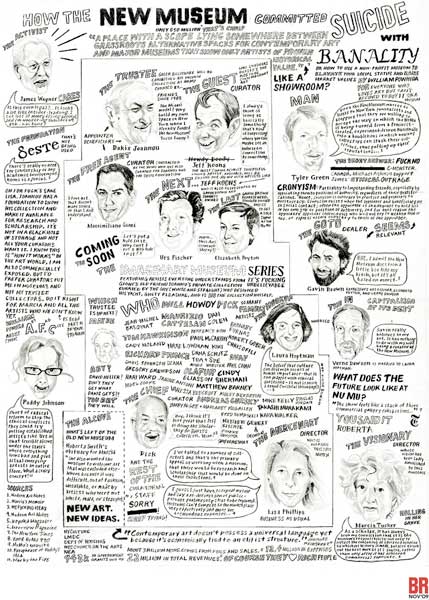- viral symphOny (2006-2008)
- Rebecca Horn: Theatre of Metamorphoses & Body Fantasies
- Zentrum für Kunst und Medien Karlsruhe & Viral Venture
- Joseph Nechvatal on Viractuality in 2000
- Before and Beyond the Bachelor Machine
- CARTE BLANCHE
- Review of Gordon Matta-Clark: Anarchitect
- Review of Ryoji Ikeda: continuum installation
- The Erotically Charged Technophilia Cyberpunk Paintings of Agustin Fernandez
- Review of the art brut show Turbulence in the Balkans
Andy Warhol: The Last Decade at The BROOKLYN MUSEUM
James Kalm was given full access to record this walk through of Andy Warhol: The Last Decade, and wishes to thank the Brooklyn Museum of Art for the privilege. It's been nearly a quarter century since Andy's death, but his visage within the art world has never been more prominent. As one of the most influential artists of the Twentieth Century, he's been credited with everything from the founding of Pop Art to social networking to developing self promotion to the highest of art forms. This massive show is loaded with documentary artifacts and presents many never before seen works from Warhol's late "abstract" series and his collaborative works with Jean-Michel Basquiat and Francisco Clemente. The exhibition was organized by the Milwaukee Art Museum.
Boris and Lil and Jean, Still Lost in the Forest of Arden

Lil Picard and Counterculture New York
Grey Art Gallery, NYU
April 20 - July 10, 2010
Like gaseous bubbles through the stagnant green waters over tar pits, forgotten artists from the past occasionally exhibit in New York. These exhibitions can often burst with noxious fumes of archival decomposition. Of course the art works of the dead are mangled and mishandled. Their messages – or for those you don't like that phrase, the living force of their life's work – is always and already misconstrued.
This was the powerful sense I had upon visiting the exhibition “Lil Picard and Counterculture New York” at the NYU Grey Gallery. I knew Lil Picard (1900-1994) first as a curious European antique – one of the grande dames of the Fluxus circle when I was a babe in the woods of NYC. Much later, I read her writing for the East Village Other, where she was an impassioned partisan of the anti-war avant garde of the 1960s. This show filled that picture in some by showing that Lil Picard also was part of this group. She wrote as a critic, for money (in German) and for love (in the EVO), but she was also an artist. That “also” got her slapped as a Sunday painter by the professionalized U.S. avant-garde.
THE HISTORY OF “WE”: HIS STORY, HER STORY, OUR STORY

Alfred H. Barr Jr.’s Diagram from the Museum of Modern Art exhibition Cubism and Modern Art, 1936.
----
Is knowledge of art history passé? Not if you want to be an artist. Here's why, from my latest Brooklyn Dispatch from the July/August issue of the Brooklyn Rail:
Anyone who knows me, or who might have followed my ramblings over the last several years now, would be aware that I have a great interest in the history of New York’s art community. This fascination started gradually (I’m a slow learner), when it dawned on me that to understand the mystery of art, you had to know the history of art. After 30 years on the scene, it’s obvious that despite what I’d been taught in art school—that it all depends on talent, dedication, and discipline—there are other factors that play important roles in deciding, who succeeds or fails in the art world. Chief among these are the relationships and connections among artists, galleries, critics, curators, collectors, and institutions, things as simple as where you live, who your friends are, where you went to school, or where you hang out. To get the big picture, one must be able to view these associations over a broad timeline. What might appear as chance happenings today may actually be the results of decisions or actions that took place in the 1950s, the 1980s, or last year. A thorough grasp of art history and its ancillary events is required, because you can’t know where you’re going until you know where you’ve been.
Charles Burchfield at the WHITNEY Curated by Robert Gober
James Kalm appreciates the efforts of the Whitney Museum and celebrity curator Robert Gober and is thrilled to bring viewers this glimpse of Charles Burchfield's "Heat Waves in a Swamp". Although classified as an "American Scene" painter during the 1930s, Burchfield was a true visionary artist. Using the humble medium of watercolor, his interpretations of the landscape and rustic urban settings, vibrate with a hallucinatory exuberance. Whether forest, field or street Burchfield's vision was open to cosmic harmonies that could overwhelm with their intensity or sometimes disturb with disquieting sinister qualities. Includes extended statements on the artist by curator Robert Gober.
Rammellzee 1960 - 2010

June 30, 2010. News has reached us from various Twitter accounts and other sources on the passing yesterday of legendary graffiti artist and hip-hop musician Rammellzee.
from Gawker:
Rammellzee, the pioneering hip hop artist and Wild Style star whose ten-minute-plus 1983 record Beat Bop is still fresher than just about anything on the radio, has apparently died.
His death was first announced on the Twitter page of Fab Five Freddy, who would know; and early this morning, a post went up on Rammellzee's Myspace page reading in part "...in mourning..as i type this, i'm numb from overwhelming sadness.....The Equation The Ramm:Ell:Zee has left his physical....left his pain." Details are unclear.
The Madness of Art

The Madness of Art is a sitcom set in the Chelsea art world, and more particularly in the Jim Kempner Gallery on the corner of Tenth Avenue and 23rd Street. Ten episodes have come out thus far, of which the ninth (with sculptor Bernar Venet) is embedded below.
94.5º ARC x 14 from Jim Kempner on Vimeo.
~~~~~~venus©-~Ñ~vibrator, even (part xi)
~~~~~~~~~~~~~~~~~venus©-~Ñ~vibrator, even (part xi)
What you find here as sound/image/text draws from my 39,907 word cyber-sex farce called ‘~~~~~~~~~~~~~~~~~venus©-~Ñ~vibrator, even’ - which I wrote during my artist-in-residency at the Cite des Art International in Paris during 1995. I edited it to this final version in NYC in 1999.
Ventriloquizing Gramsci

I heard the opening movement of the requiem for communism, The Gramsci Project, as it was played at LaGuardia Community College. Standing before a photo blowup of the sainted Depression-era mayor of New York pressing the flesh, artist Thomas Hirschhorn presented a slide show about the Bijlmer Spinoza-Festival he produced in 2009 in a housing project outside Amsterdam. He was invited to Queens by professor Charity Scribner as part of her class’s Gramsci Project.
Uneasy Rigor: Dennis Hopper, curated by Julian Schnabel, at Jeffrey Deitch's MOCA/LA

April 16, 2010. News that the first exhibition planned by Jeffrey Deitch as the new director of MOCA/LA will be a survey of work by Dennis Hopper, curated by Julian Schnabel, must be greeted with mixed feelings.
On the one hand, Hopper is undeniably a prodigious, mythic presence on the American scene, mostly due to his extended Hollywood career as actor and director. He helped define the counterculture in Rebel Without a Cause and Easy Rider, and raised the stakes with fierce performances in Apocalypse Now and Blue Velvet. He is also an early and important member of the West Coast art demimonde, friendly with many of LA's more radical practitioners, including Wallace Berman, Ed Ruscha and Billy Al Bengston. He started buying art in the late 1950s and owns one of the Warhol soup can paintings from the historic exhibition at Ferus Gallery, among a varied and extensive collection that includes Keith Haring and Jean-Michel Basquiat as well as Schnabel.
William Powhida in A Tale of Three Covers

William Powhida, How the New Museum Committed Suicide with Banality, cover art, Brooklyn Rail, November 2009
(For a larger, more legible image, click here.)
----------------------
December 25, 2009. The Brooklyn Rail, founded in 1998, is a scrappy, independent cultural/political broadsheet that covers issues in Brooklyn's waterfront neighborhoods (Williamsburg, Greenpoint, DUMBO, Red Hook) from a politically progressive vantage point. It publishes poetry and fiction and reviews local developments in music, film, dance, theater and books. Most significantly, it provides passionate, detailed, idiosyncratic coverage of the NY arts scene in each and every issue, with a full roster of exhibition reviews, feature articles and long, in-depth "conversations" with artists. Under publisher Phong Bui, it has developed an essential and original voice, and is part of my regular reading list. [Full disclosure: James Kalm, who maintains an ongoing video blog here at post.thing.net, has also contributed regularly to the Rail.]
Viewable online, distributed for free at certain bookstores and alt.culture locations, and also available by subscription, the Rail has a relatively small circulation (around 7,500). Even so, it regularly engages in adventurous promotional efforts normally the province of larger publications; for example, the printing of multiple covers for certain issues to better showcase the artists and contents within.
A case in point: the three different covers of the November 2009 issue. The one I have at home features an image from a Carroll Dunham painting. I understand there was also a Helmut Federle cover. (Both artists had solo shows in NY that month and are interviewed in the November Rail.) However, it is the third cover choice I wish to address here, a b/w drawing by artist, activist, satirist and draftsman William Powhida, executed in full caricature/agitprop mode (and pictured above), in which he addresses cronyism at the New Museum in gleeful, graphic, subversive detail.
James Allan
Isabel Arvers
Chris Byrne
Blackhawk
Renaud Courvoisier
Peggy Cyphers
Ricardo Domiguez
Spy Emerson
Ian Epps
Peter Fend
Marc Garrett
Jan Gerber
Arfus Greenwood
G.H. Hovagimyan
Jerome Joy
James Kalm
Steven Kaplan
Patrick Lichty
Joerg Lohse
Frederic Madre
Christina McPhee
Alan W. Moore
Robbin Murphy
Joseph Nechvatal
netwurker
Onajide
meine palin
Darrel O'Pry
R.E. Poster
Keith Sanborn
Wolfgang Staehle
ART STOMP
Caspar Stracke
Lydwine Van Der Hulst
Lee Wells
Philip von Zweck
9 years 19 weeks ago
10 years 29 weeks ago
11 years 49 weeks ago
11 years 51 weeks ago
12 years 6 weeks ago
12 years 6 weeks ago
12 years 6 weeks ago
12 years 6 weeks ago
12 years 7 weeks ago
12 years 9 weeks ago